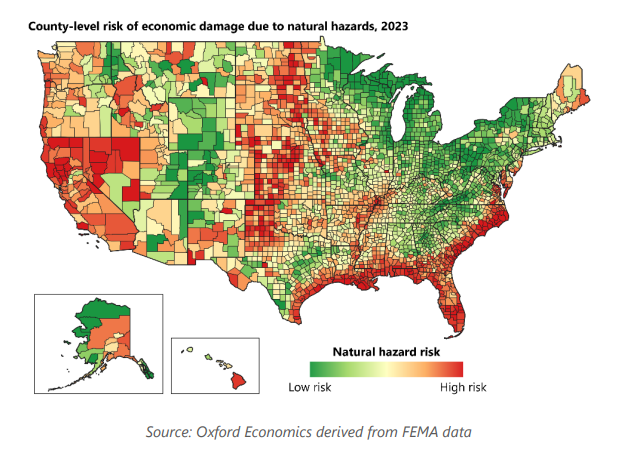People are moving to US metros with high natural hazard risks
Metros with the fastest population growth are among those with the highest natural hazard risks. Using FEMA’s National Risk Index, we estimate the share of each metro’s GDP expected to be lost on an annual basis due to natural hazards. Many of the high-risk metros are along the southeastern coast of the US, the area that saw the highest rates of in-migration in 2023.
What you will learn:
- We forecast this trend to continue in the medium term. Some of the fastest-growing metros over the next five years, such as Houston, Orlando, Myrtle Beach, Lakeland (FL), and The Villages (FL) are among those most at-risk from natural hazards. Collectively, 3.8 million additional people will live in high-risk metros by 2028.
- The continuation of this trend is particularly worrying because many of the natural hazards included in this analysis are expected to intensify due to climate change. The economic damage caused by hurricanes, wildfires, and droughts (among other hazards) is likely to increase in the coming years.
- But people aren’t just relocating to metros with economies at risk of disruption. In some cases, they are also moving to places where the environmental conditions have been linked with increased mortality rates, such as Charleston (SC) and Lake Charles (LA). The increased length and intensity of heatwaves across the country are also raising the health risks associated with moving to many metros.

Tags:
Related Services

Service
US States and Metro Service
Forecasts, scenarios and analysis for US states, metropolitan statistical areas and counties.
Find Out More
Service
US Forecasting Service
Access to short- and long-term analysis, scenarios and forecasts for the US economy.
Find Out More
Service
City Scenarios Service
Assess the impact of risk scenarios on cities and regions Our service provides a baseline forecast and three alternative scenarios for a broad range of economic and demographic indicators for each location.
Find Out More